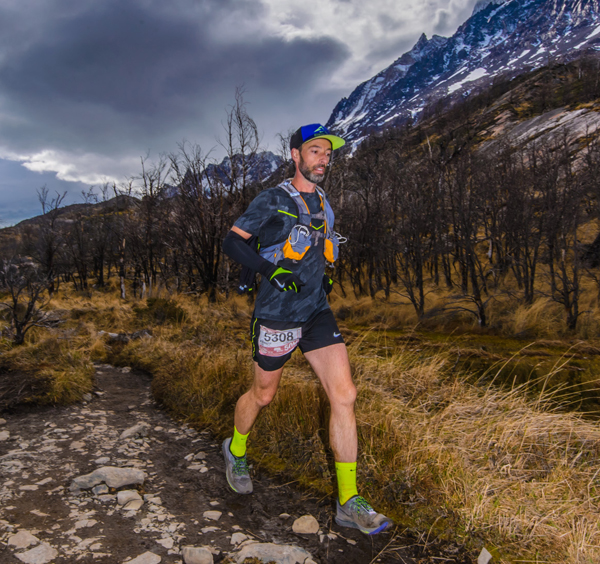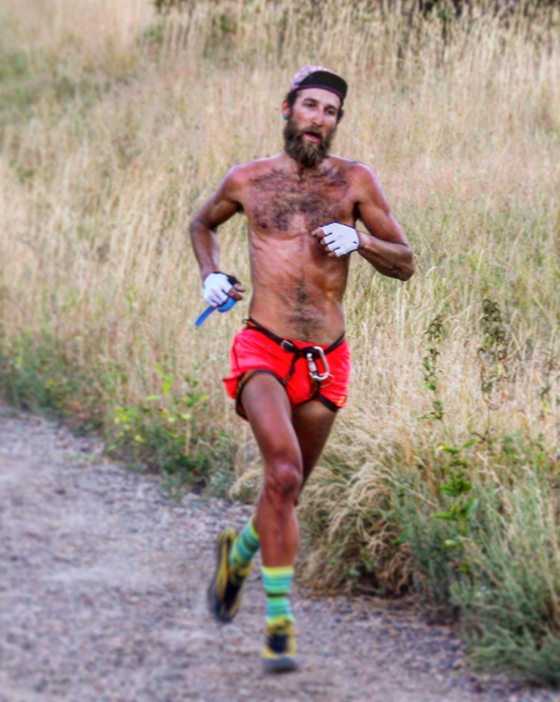
The Ultra Trail Torres de Paine took place last weekend. Photo © Graciela Zanitti | iloverunn.com.ar
Connections
“I call it my catharsis” he tells me.
Tito is gesturing to his stomach with clenched fists, describing the feeling that overcame him while running the trails of the Eighth Natural Wonder of the World.
“It’s like PHHFFF!” he thrusts out his fingers “and there’s something firing out of me, connecting me to everything else. It’s happened only a few times before – when I’ve been alone, usually in the mountains, and it happened to me yesterday at Torres del Paine.”
Before Tito even began the Ultra Trail Torres del Paine, he made the odyssey of a journey to its extreme southerly start line. I had arrived the previous weekend for the Patagonian International Marathon road race, gawping as I ran along the shore of Lago Nordenskjöld at the otherworldly mountains across the lake.
Now however, I would be thrown inside them. This trail race would explore three southern valleys in the Torres del Paine massif. The 50km journey across glacier-gouged slopes, boulder-strewn gorges and sinuous single-track is known as the “W.” Trekkers come from all over the world to complete the infamous tour, usually taking three to four days. The race organisers allowed just 11 hours.

The race explores three southern valleys in the Torres del Paine massif. Photo © Graciela Zanitti | iloverunn.com.ar
Valle Ascencio
The pace was hot and fast from the start-line. The runners around me soon silent with steady breathing, measured movements and private focus. We worked our way into the mountains up a steep escarpment. From here a trail cut aggressively across a wide scar of glacial moraine, long since ripped from the mountain, and covered in a softer tissue of grass and grazing horses.
We pattered uphill. The Chilean runners: Moises Jimenez and Enzo Ferrari just out in front; the Brazilian, Fernando Nazario on my hip and Bryan Toro from California shadowing behind. Momentarily the Ascencio valley flared wide and open, and then quickly pulled us in, roller coasting us down its river cut flanks of scree towards the water which seemed to rush uphill towards us like the impossible staircase of an Escher drawing.
A wooden bridge led into tight deciduous forest and a hopscotch of sidesteps and ducking. Polished trees marked the trail, where burdened backpackers had hauled themselves uphill. Overhead, the Paine towers would make occasional pallid appearances in the low grey light. But mainly concentration was on closer things: tree roots, flashes of blue cotton between branches and the pressing sound of close footfall behind.

Trekkers complete the infamous tour in three to four days – the race organisers allowed just 11 hours. Photo © Graciela Zanitti | iloverunn.com.ar
Choosing to run
Choosing to run, rather than walk, means the stimulation from the outside world is turned down. The bass drum of avalanche, drowned by the sloshing of water bottles. The playing of wind over high crags, replaced by the scramble of footsteps and breathing. And yet it is not a lesser experience. Running 50km in the mountains requires control of your exertions, and focus on the needs of the absolute present. Your emotions turn inwards. It is, if you will, meditation. Its lessons are in patience, perseverance and of purpose. When you do look up, the grandeur of the landscape is not something to be marvelled at, but as Moises Jimenez said, who was leading the race, “something you are part of”.

Clara Serino from Buenos Aires pushing for her second place finish. Photo © Graciela Zanitti | iloverunn.com.ar
The hunt
Three hours in and my eyes were fixed to the ground, tiptoeing carefully across the dry stones of a river. On the other side, there were tracks, fresh and wet. The panicked runner in second place must have spooked straight in, and waded out with leadened feet to begin the long climb into the Valle Francés. Two hours ago Enzo had been moving so swift and nimbly when he pulled away. Now he was being worn down by the mountains; tired from the chase; running lame and leaving telling stains on the dusty trail.
I turned steadily north into the second valley; the icy Cuernos del Paine shifting aspect each time I risked a look up. A long climb began and the American was right on my tail, chasing me wretchedly as I clambered over boulders and pedalled leg-sappingly through scree. Deep into the race, focus was now hard and whittled. Sweat ran into my eyes; the mountains momentarily washed away. Then back again. Hands pumping on my knees. Testing one another to the edge of exhaustion; grating ourselves against the mountains.
As we moved up into the snow line a hot rub was building in my eyes again, but it wasn’t sweat this time. I felt it building in my face, behind my eyes. Ready to burst…

Matt Maynard tailed by Bryan Toro as hikers look on.
Tears on the trail
Alexis, a Chilean journalist, came and trained with some of the runners in the build up to the race. The summit we set out for was much further than expected. As Alexis stumbled up through the snow and birch forest with the pitio birds whistling in the undergrowth, he began to cry. Big boys aren’t supposed to cry. Especially macho Chilean ones. But it’s surprising how the mountains break you down. As Moises Jimenez explained to me after the race: being out in wild and unexplored places is an emotional experience that can provoke tears. These are not tears of self pity or sadness however. They are an expression of a deep seated relationship with nature and with life. The emotion, he explained, is almost unbelievable. It’s directed at something and not someone. But the name for it is clearly Love.

While pushing their bodies to the limit the trail also allows runners to immerse themselves in incredible nature. Photo © Graciela Zanitti | iloverunn.com.ar
Catharsis
At around the marathon distance mark, the UTTP makes its third and final climb, weaving up into the Grey Valley. If you study the course profile, you’ll know this last climb is demandingly runnable and if you stop to walk, you are going to get overtaken. The ‘W’ however has been grinding your muscles with its steep technical trails for the last 40k and the rush of beauty and hardship you have been swilling around in has become a disorientating fog. Enzo was just ahead now, making one last frenzied dash and Bryan Toro had already leapfrogged past to reel him in.
At the first kicker in the terrain they both stopped to walk. Enzo was bleeding at the knee after a fall and Bryan didn’t seem to respond this time like he had before. I grimaced past, hoping to appear to be running strong. The landscape roared open again: Lake Grey below with discarded icebergs fading slowly, and then higher still – the first sight of Glacier Grey – a long lick of millennial ice, attached to the mountain swallowing throat of the Hielo Sur ice pack. I ran on in a craze of ambition and effort, punctuated by cramps in my feet and choked by lumps in my throat that I would wash clear with intermittent deep groans of pain and satisfaction.
The final turn around point was on an isolated rocky outcrop on the glacier’s edge. As you approached, there was a cool sucking of air that dragged you towards it: the ice pack creating its own wind, pulling the life out of the air and into its interminable crevasses. Standing over the great precipice, it was here that Tito would have his catharsis. “Oh God” he would say, as the feeling overtook him.

Race leader Moises Jimenez approaches the glacier. Photo © Graciela Zanitti | iloverunn.com.ar
Ending
I crossed the finish near the shore of Lago Pehoé in 2nd place, after five hours and 46 minutes on the trail. Moises Jimenez had been waiting more than 20 minutes and embraced me tightly with the same inimitable passion he had flowed past me with, every time we crossed paths in the three valleys. Bryan and Enzo arrived safely shortly afterwards.
As the afternoon wore on, the news of a tragedy sifted slowly among the runners. A 24-year-old runner, Jonatan Canto from Argentina, had died in the Valle Francés. It is suspected that he suffered a sudden and fatal heart attack.
Beneath the Cuernos del Paine towers, a minute of silence was held in respect. A boat then arrived across the still lake. The runners were ferried solemnly over Lago Pehoé in full sight of the mountains they had come down from. The majesty of landscape Jonatan died in would never make his death more consolable. In being part of it however – where you can cry and fall in love – at least we can be sure he had lived.

Photo © Graciela Zanitti | iloverunn.com.ar
Matt Maynard is a British freelance writer living in Santiago, Chile. You can contact him at GreenBeanTrails.com if there is something you think he could write for you.
Results from the race, and details of the 25km race and the vertical kilometre event are available at ultratrailtorresdelpaine.com.








